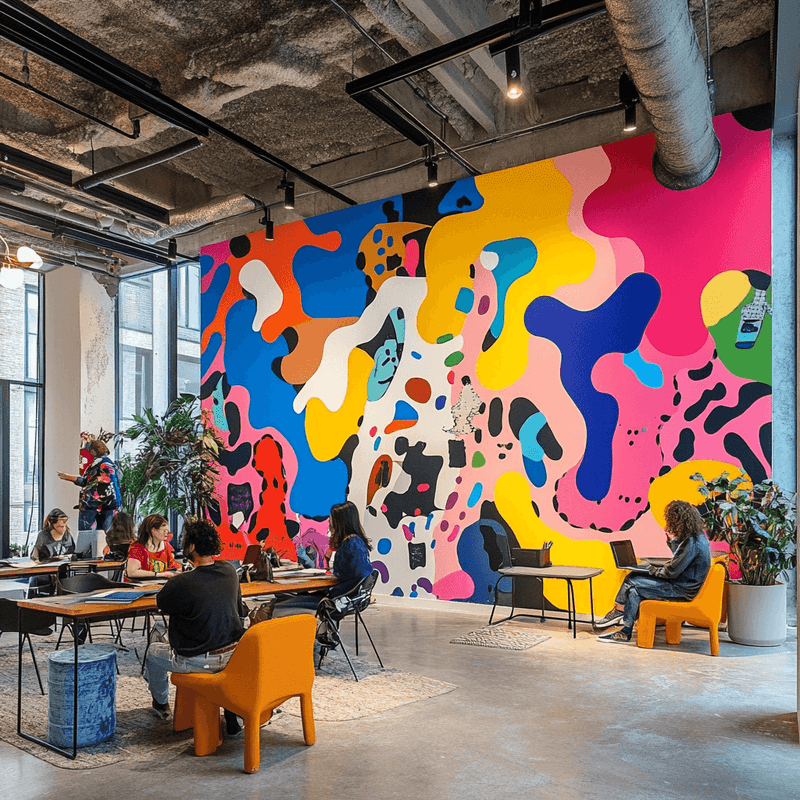
So we're going to put our foot down right now, and try to explain why use should always come first when choosing your flexible workspaces, and why it's imperative to think in terms of the number of workstations rather than the number of m² (That's So pre-covid!). In today's fast-changing professional world, the question of workspace is posed in a very different way.
Traditionally, we used to talk in terms of square meters, but this area-based approach is now showing its limitations in the face of new practices and expectations in terms of flexibility. Assessing needs in terms of workstations and usage, rather than square meters, helps optimize costs, promote employee well-being and adapt space to the specific needs of the company. We explain it all!
Why not talk in m²? Usage comes first
A flexible office requires thinking that goes far beyond simple surface measurement. When we think in terms of workstations, we're interested in the activities and movements of employees, not the dimensions of walls. This approach is based on the principle that each workstation should be designed to enable a specific activity to be carried out, and to provide optimum working conditions, rather than to meet a minimum number of square meters per person. In addition, as we know, with the rise of telecommuting, office space is shrinking, and workstations are now shared between several employees according to the number of days they are present on company premises or in the flexible spaces they occupy.
It's also worth noting that the law doesn't stipulate the number of square meters per employee. More precisely, the French Labor Code does not set a minimum surface area in m² for each employee, but does impose criteria relating to the safety and well-being of employees. Article R 4214-22 of the French Labor Code specifies that the workspace must be adapted to ensure that everyone has sufficient freedom of movement, both in terms of height and surface area, and working conditions that are free from health and safety risks. Although no strict rules are laid down, standards exist as recommendations.
For example, AFNOR standard NF X 35-102 (voluntary) recommends 10 m² for an individual office, 11 m² for a shared space, and 15 m² for noisy areas. These standards, though optional, can guide companies in providing comfortable workspaces. The COVID-19 crisis has also served as a reminder of the importance of sufficient space to limit the spread of disease and ensure a healthy working environment.
6 essential criteria for determining actual m² requirements
So how do you determine the surface area your company really needs, and more specifically if you want to rent flexible workspaces? Here are six criteria to consider when assessing your specific needs:
1. Work organization: telecommuting or face-to-face
Telecommuting reduces the need for fixed offices for each employee. A 100% remote company could opt for flexible solutions such as coworking or one-off office rentals, thus avoiding the costs of a long-term lease. Conversely, if the business requires a daily presence, this will influence the choice of surface area to accommodate all employees.
2. Type of business and equipment requirements
Space requirements also vary according to the company's activities. For example, teams with storage needs (IT, specific equipment) or activities requiring quiet spaces for concentration (develovelopers, graphic designers) will have different needs to those of teams who hold regular meetings or receive customers.
3. Location and its budgetary implications
The location of your offices has a direct impact on your budget. In large cities, where property prices are high, it's essential to optimize every square meter. In Paris, for example, high rents force companies to adjust their surface area and optimize each workstation to avoid unnecessary expenses.
4. The choice of workspace: open space or closed offices
The choice between open space and closed offices depends on corporate culture and working style. Open space, favored by start-ups for its lower costs, is on the other hand criticized for the noise it can cause. A partitioned space often requires more m² per person, but improves confidentiality and comfort, especially for activities requiring greater concentration.
5. Communal areas: meeting rooms, kitchen, relaxation areas
These spaces must be taken into account when assessing the total surface area. We generally estimate between 3 and 4 m² per person for collective spaces. A meeting room for 4 people requires an average of 12 to 16 m², while a relaxation area or kitchen can cover around 10 m². These spaces are essential for well-being at work, but must be sized according to actual use.
6. Grey" spaces: corridors, technical rooms, washrooms
Although these areas are not directly dedicated to work, they are essential for accessibility and comfort. To avoid unnecessary overloading of m², we recommend modern buildings offering better optimization of these spaces.
A well-designed workspace, a key factor in well-being
Finally, thinking of offices in terms of workstations rather than m² has a direct impact on employee well-being. A comfortable space adapted to their activities improves productivity and satisfaction. It's also crucial to pay attention to elements such as temperature, air quality and workstation ergonomics, all of which play a role in well-being at work.
Determining the ideal surface area for your offices requires a complex assessment that takes many factors into account. Rather than calculating a fixed number of m² per employee, it makes sense to focus on workstations and actual usage. This approach will optimize your costs, adapt your spaces to new ways of working, and offer your teams a more flexible and pleasant working environment.
-
How do companies assert their identity in a shared space?

12/05/2025 How do companies assert their identity in a shared space?
Coworking spaces are places designed for the collective: so how can a company assert its own identity? While flexible space brands strive to be recognizable and identifiable among a thousand, they also enable their occupants to make their own workspaces their own.
-
Coworking: how to create, open and run a shared workplace?

03/05/2025 Coworking: how to create, open and run a shared workplace?
Coworking spaces are springing up all over France. How do they emerge today, and what room is left for new entrants to the flexible workspace market?
-
Coworking: how to prepare employees for flexible working?

03/04/2025 Coworking: how to prepare employees for flexible working?
As coworking spaces win over more and more employees, how can companies support this shift towards greater flexibility, without losing cohesion or performance? Here are a few tips!